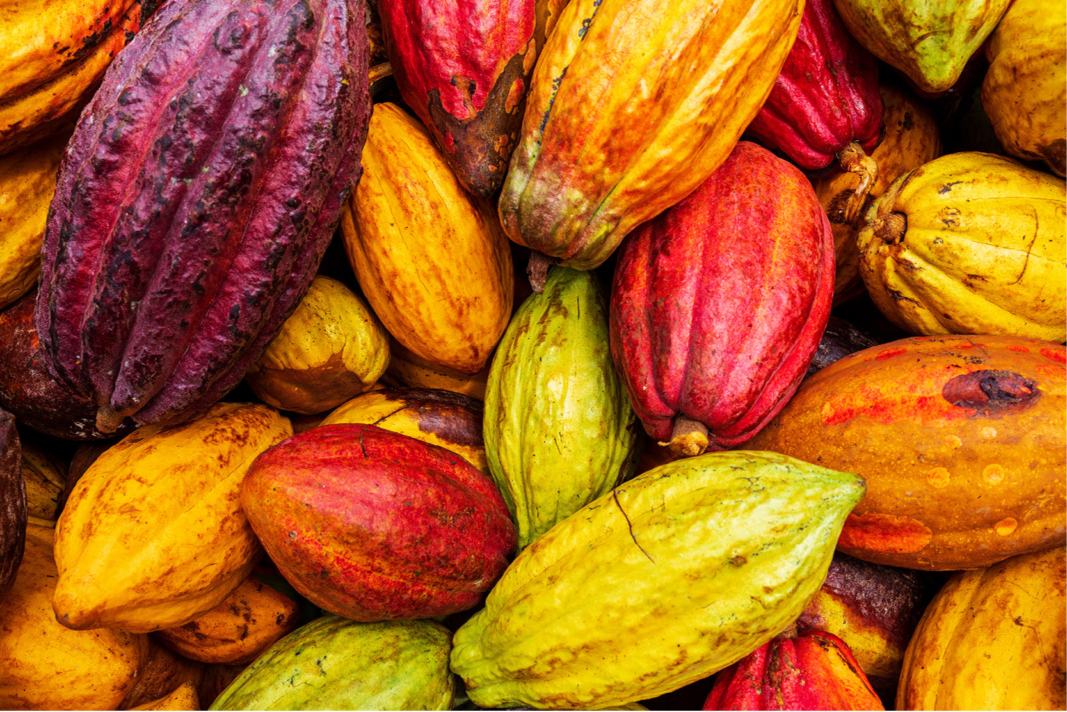SWEET

CHOCOLATE!!! What more needs to be said? Read on to find out… :)))))))
Another favorite time for me is Easter morning – and memories of my girls hunting for their easter baskets, filled with Resses’s Easter eggs, jellybeans, and of course yummy chocolates. Our rules were simple, you had to find your basket, if you found someone else’s nothing could be said. Occasionally one of them would not be able to find their basket before church, it goes without saying that they were not happy during mass. Over the years Jackie and I had to get very creative in hiding the baskets which I think was half the fun! With Easter around the corner, and for many of you who gave up chocolate for Lent, I thought I’d share with you some chocolate trivia you can consume and share with the family. It’s no surprise that chocolate has been around for some time … in an article published by The University of British Columbia, a study uncovered evidence of cocoa’s domestication between 5,300 and 2,100 years ago. It’s no surprise that cocoa and chocolate have been delighting consumers for some time. So, here is some fun music to click on, and fun facts to enjoy. Thanks to wired.com, The Natural History Museum of Utah, thechocolatewebsite.com, Google, Wikipedia, forbes.com, theguardian.com, and YouTube for the info and links.
Chocolate comes from the cacao tree, which is native to Central and South America.
The fruit of the cacao tree is a melon-shaped pod that grows directly from the tree’s trunk or limbs. The pods begin as small flowers, which are pollinated by a tiny midge (rather than a bee). Successfully pollinated flowers bear fruit, and that fruit becomes the cacao pod. There are anywhere from 20 to 50 cream-colored seeds (called beans) inside each pod. The seeds, each roughly the size of an olive, are surrounded by a milky-white pulp. As pods ripen, they turn varying shades of orange, yellow, and red.

Although cacao originated in Central and South America thousands of years ago, over 66% of the entire world’s cacao is grown in Africa. Côte d’Ivoire alone produces over 33% of the world’s supply of chocolate. 90% of the world’s cacao is grown on small family-run farms, no larger than 12 acres. . Typically, there are two annual harvests. Cacao trees can live to be 200 years old, but they produce marketable cocoa beans for only 25 years.
The word “chocolate” comes from the Aztec word “xocolatl,” which means “bitter water.”
and the name for the cacao plant, Theobroma cacao, means “food of the gods.” Jackie would absolutely agree with this! . As early as 1900 B.C., a prehistoric culture called the Mokaya were processing and consuming a liquid that seems to have been chocolate.
Over the following millennium, chocolate became an important drink in Mesoamerica. It was used in rituals like burials, weddings, and baptisms by the cultures that followed: the Olmecs, the Mayans, and the Aztecs. It was so valued that it was used in place of money by the Mayans and Aztecs. According to a 16th-century Aztec document, one cacao bean could be traded for a tamale and 100 could be traded for a turkey hen.
Chocolate was originally consumed as a bitter beverage, and it wasn’t until the 16th century that sugar was added to make it sweeter.
But before chocolate became the sweet worldwide phenomenon we know today, Mesoamerican cultures made bitter drinks with the cacao bean. Some of these drinks were made of the fermented pulp around the beans, and their drinking chocolate was made from the ground cacao bean, water, and flavorings like corn, chilies, honey, vanilla, and agave syrup.
Cacao only grows in certain climates.
Chocolate emerged as a product of Mesoamerica, although cacao is native to South America, specifically the Amazonian basin. While we think of vigorous vegetation when we consider Amazonian rainforests, it turns out that cacao is a finicky plant to grow. In fact, cacao only grows within 20 degrees latitude (north and south) of the equator. The trees need light, but not too intense UV light. They need humidity and moisture, generally 40-100 inches of rain per year. And they need constant, warm-to-hot temperatures all year long (60-90 degrees Fahrenheit). The pollinator for this tree is also a very small midge that only thrives in a very humid and moist environment.
White chocolate is not actually chocolate at all, as it contains no cocoa solids.
White chocolate is a confectionery typically made of sugar, milk, and cocoa butter, but no cocoa solids. It is pale ivory in color,
In 1937, the white chocolate Galak was launched in Europe by the Swiss company Nestlé. From about 1948 until the 1990s, Nestlé produced a white chocolate bar with almond pieces, Alpine White, for markets in the US and Canada. Hershey began mass production of white Hershey’s Kisses in the 1990s, a product that diversified during the early 21st century to include a chocolate white-dark swirl Kiss called the Hug.
The world’s largest chocolate bar weighed over 12,000 pounds and was made in Italy in 2010.
The largest chocolate bar weighed 12,770 lb 4.48 oz and was created by Thorntons PLC in Alfreton, Derbyshire, UK on October 7, 2011. The chocolate bar measured 13 ft 1.48 in by 4.0 13 ft 1.48 in by 1 ft 1.78 in. https://www.theguardian.com/lifeandstyle/2011/oct/12/chocolate-world-record-broken-by-thorntons
Chocolate has been shown to have numerous health benefits, including reducing the risk of heart disease and stroke.
One fact is clear for chocolate: the purer and darker the chocolate, the greater your health benefits.. Dark chocolate has anywhere from 50 to 90 percent cocoa solids, while milk chocolate is typically 10 to 30 percent. To get noticeable health benefits from chocolate, you need to eat more of the cocoa solids found in dark chocolate. Cocoa solids contain minerals and antioxidants;. Dark chocolate is especially rich in flavanols like epicatechin and catechin, as well as anthocyanins and phenolic acids. All of these compounds help protect your cells from inflammation, improve your brain function, and boost your immune and cardiovascular health. Dark chocolate can also give you cardiovascular support.
The antioxidants in dark chocolate help to lower bad cholesterol levels and prevent plaque on artery walls, while the flavanols in chocolate are good for lowering blood pressure and improving blood flow. Eating dark chocolate in moderation can lower your chances of heart disease and also ease lower inflammation in the body. Plus, theobromine (mentioned earlier), a compound in dark chocolate, has similar effects to caffeine for boosting energy and overall morale. It helps to enhance mood and make you more alert. All said, I’ll have another bite!
The Swiss consume more chocolate per capita than any other country in the world.
The Swiss are the leaders in per capita consumption, weighing in at 19.8 lbs per person, with Germany second, Ireland third and UK fourth. The US is ninth, at 9.5lbs – equal to about 2.8 billion pounds per year. That said, I’ll do my best to help us move up in the rankings.
May you enjoy a blessed Easter, and rejoice in HIS glory.

::::::::::::::::::::::::::::::::::::::::::::::::::::::::::::::::::::::::::::::::::::::::::
DO YOU LIKE CONTESTS?
Me, too.
As you may know the Kowalski Heat Treating logo finds its way
into the visuals of my Friday posts.
I. Love. My. Logo.
One week there could be three logos.
The next week there could be 15 logos.
And sometimes the logo is very small or just a partial logo showing.
But there are always logos in some of the pictures.
So, I challenge you, my beloved readers, to count them and send me a
quick email with the total number of logos in the Friday post.
On the following Tuesday I’ll pick a winner from the correct answers
and send that lucky person some great KHT swag.
So, start counting and good luck!
Oh, and the logos at the very top header don’t count.
Got it? Good. :-))))
Have fun!!
::::::::::::::::::::::::::::::::::::::::::::::::::::::::::::::::::::::::::::::::::::::::::



Leave a Reply
Want to join the discussion?Feel free to contribute!